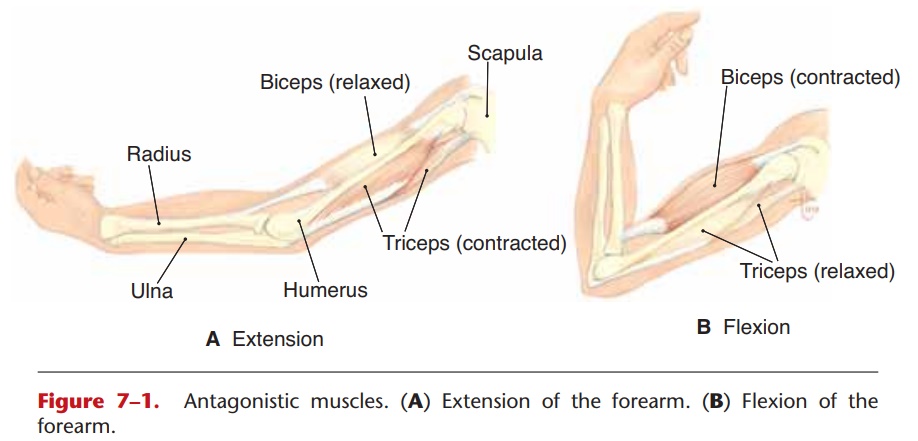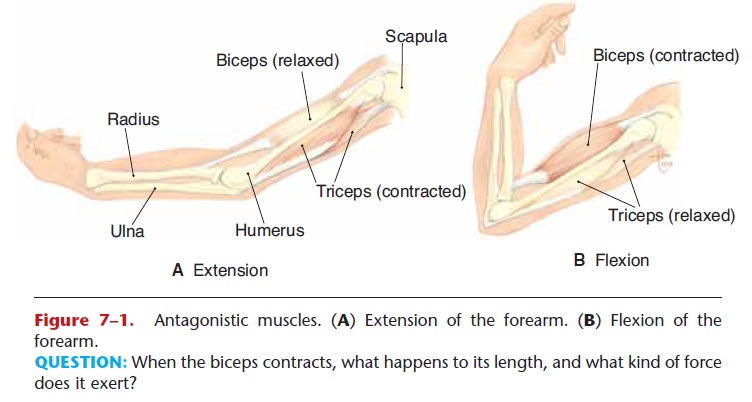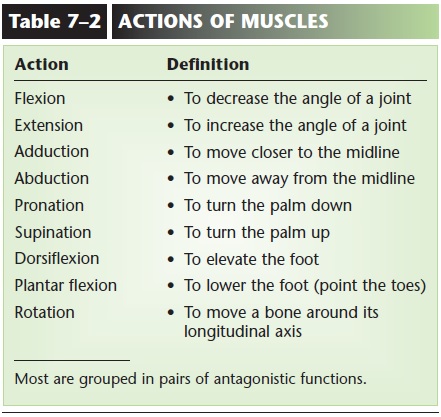Chapter: Essentials of Anatomy and Physiology: The Muscular System
Muscle Structure

MUSCLE STRUCTURE
All muscle cells are specialized for contraction. When these cells contract, they shorten and pull a bone to produce movement. Each skeletal muscle is made of thousands of individual muscle cells, which also may be called muscle fibers (see Fig. 7–3). Depending on the work a muscle is required to do, variable numbers of muscle fibers contract. When picking up a pencil, for example, only a small portion of the muscle fibers in each finger muscle will contract. If the muscle has more work to do, such as picking up a book, more muscle fibers will contract to accomplish the task.

Muscles are anchored firmly to bones by tendons. Most tendons are rope-like, but some are flat; a flat tendon is called an aponeurosis. Tendons are made of fibrous connective tissue, which, you may remember, is very strong and merges with the fascia that covers the muscle and with the periosteum, the fibrous connective tissue membrane that covers bones. A muscle usually has at least two tendons, each attached to a different bone. The more immobile or stationary attachment of the muscle is its origin; the more movable attachment is called the insertion. The muscle itself crosses the joint of the two bones to which it is attached, and when the muscle contracts it pulls on its insertion and moves the bone in a specific direction.
MUSCLE ARRANGEMENTS
Muscles are arranged around the skeleton so as to bring about a variety of movements. The two general types of arrangements are the opposing antagonists and the cooperative synergists.
Antagonistic Muscles
Antagonists are opponents, so we use the term antag-onistic muscles for muscles that have opposing or opposite functions. An example will be helpful here— refer to Fig. 7–1 as you read the following. The biceps brachii is the muscle on the front of the upper arm. The origin of the biceps is on the scapula (there are actually two tendons, hence the name biceps), and the insertion is on the radius. When the biceps contracts, it flexes the forearm, that is, bends the elbow (see Table 7–2). Recall that when a muscle contracts, it gets shorter and pulls. Muscles cannot push, for when they relax they exert no force. Therefore, the biceps can bend the elbow but cannot straighten it; another muscle is needed. The triceps brachii is located on the back of the upper arm. Its ori-gins (the prefix tri tells you that there are three of them) are on the scapula and humerus, and its inser-tion is on the ulna. When the triceps contracts and pulls, itextends the forearm, that is, straightens the elbow.

Figure 7–1. Antagonistic muscles. (A) Extension of the forearm. (B) Flexion of the forearm.
QUESTION: When the biceps contracts, what happens to its length, and what kind of force does it exert?
Joints that are capable of a variety of movements have several sets of antagonists. Notice how many ways you can move your upper arm at the shoulder, for instance. Abducting (laterally raising) the arm is the function of the deltoid. Adducting the arm is brought about by the pectoralis major and latissimus dorsi. Flexion of the arm (across the chest) is also a function of the pectoralis major, and extension of the arm (behind the back) is also a function of the latissimus dorsi. All of these muscles are described and depicted in the tables and figures later. Without antagonistic muscles, this variety of movements would not be possible.

You may be familiar with range-of-motion (or ROM) exercises that are often recommended for patients confined to bed. Such exercises are designed to stretch and contract the antagonistic muscles of a joint to preserve as much muscle function and joint mobility as possible.
Synergistic Muscles
Synergistic muscles are those with the same func-tion, or those that work together to perform a partic-ular function. Recall that the biceps brachii flexes the forearm. The brachioradialis, with its origin on the humerus and insertion on the radius, also flexes the forearm. There is even a third flexor of the fore-arm, the brachialis. You may wonder why we need three muscles to perform the same function, and the explanation lies in the great mobility of the hand. If the hand is palm up, the biceps does most of the work of flexing and may be called the prime mover. When the hand is thumb up, the brachioradialis is in position to be the prime mover, and when the hand is palm down, the brachialis becomes the prime mover. If you have ever tried to do chin-ups, you know that it is much easier with your palms toward you than with palms away from you. This is because the biceps is a larger, and usually much stronger, muscle than is the brachialis.
Muscles may also be called synergists if they help to stabilize or steady a joint to make a more precise movement possible. If you drink a glass of water, the biceps brachii may be the prime mover to flex the forearm. At the same time, the muscles of the shoul-der keep that joint stable, so that the water gets to your mouth, not over your shoulder or down your chin. The shoulder muscles are considered synergists for this movement because their contribution makes the movement effective.
THE ROLE OF THE BRAIN
Even our simplest movements require the interaction of many muscles, and the contraction of skeletal mus-cles depends on the brain. The nerve impulses for movement come from the frontal lobes of the cere-brum. The cerebrum is the largest part of the brain; the frontal lobes are beneath the frontal bone. The motor areas of the frontal lobes generate electro-chemical impulses that travel along motor nerves to muscle fibers, causing the muscle fibers to contract.
For a movement to be effective, some muscles must contract while others relax. When walking, for exam-ple, antagonistic muscles on the front and back of the thigh or the lower leg will alternate their contractions and relaxations, and our steps will be smooth and effi-cient. This is what we call coordination, and we do not have to think about making it happen. Coordination takes place below the level of conscious thought and is regulated by the cerebellum, which is located below the occipital lobes of the cerebrum.

Related Topics